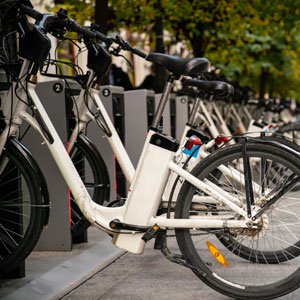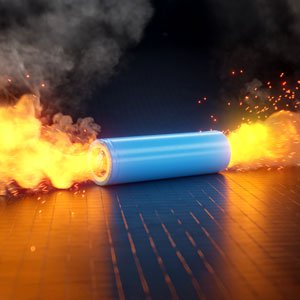Jump straight to a section:
In recent years, lithium-ion batteries have become ubiquitous in New York City’s urban landscape—powering everything from e-bikes and scooters to tools and backup systems on construction sites. But with their convenience comes a growing danger: thermal runaway, toxic gas emissions, and explosive fires that are difficult to extinguish.
In 2025 alone, the FDNY responded to over 200 lithium-ion battery-related fires, a 53% increase from the previous year. These incidents have resulted in multiple fatalities, dozens of injuries, and millions in property damage. In response, NYC has enacted a series of local laws and enforcement actions aimed at curbing the risks associated with these volatile energy sources.
Understanding Lithium-Ion Battery Fires
Unlike traditional fires fueled by wood or gasoline, lithium-ion battery fires are triggered by a chain reaction known as thermal runaway. This occurs when a battery cell overheats, causing adjacent cells to ignite in a cascading effect. Once ignited, these fires:
- Do not require oxygen to burn.
- Emit toxic gases such as hydrogen fluoride.
- Can explode violently, spreading flames and debris.
- Are resistant to standard extinguishers, requiring specialized suppression methods.
The FDNY has emphasized that ordinary fire extinguishers are ineffective against lithium-ion fires. Instead, fire departments rely on dry chemical agents, thermal blankets, and cooling techniques to contain the blaze.
Major Incidents in 2025

Several high-profile incidents have highlighted the urgency of NYC’s response:
1. Fatal E-Bike Fire in Queens (July 4, 2025)
A lithium-ion battery exploded inside a pizzeria restroom, igniting a two-alarm fire. A 76-year-old woman died from injuries sustained in the blast. FDNY Commissioner Robert S. Tucker stated, “These e-mobility devices can be extremely dangerous… they do not belong inside.”
2. Bronx Porch Fire (June 22, 2025)
A battery ignited on the front porch of a home, spreading to two neighboring houses. Fifteen people were injured, including a critically injured firefighter. Burned-out e-bikes and scooters were found at the scene.
3. Illegal Battery Charging & Gambling Den (September 2025)
FDNY inspectors investigating unsafe battery charging uncovered an illegal gambling parlor in Manhattan. The cellar was packed with clutter, space heaters, and hazardous battery setups. Multiple summonses were issued, and NYPD and DOB were called in.
NYC’s Regulatory Response
To combat the surge in fires, NYC passed a series of local laws in 2024 and 2025 that:
- Ban the sale of non-UL certified batteries.
- Require dedicated charging rooms for more than five devices.
- Mandate minimum separation distances between batteries based on kilowatt-hour capacity.
- Prohibit charging near flammable materials or blocking egress paths.
Retailers caught selling uncertified batteries face FDNY summonses, fines, and potential criminal charges. As of mid-2025, Amazon blocks shipments of uncertified batteries to NYC zip codes, and the Consumer Product Safety Commission urges consumers to look for the UL Mark on all battery-powered products. Source: NYC Lithium-Ion Safety Laws.
NYC-Specific Charging Requirements
To combat the surge in fires, NYC passed a series of local laws in 2024 and 2025 that:
- Ban the sale of non-UL certified batteries.
- Require dedicated charging rooms for more than five devices.
- Mandate minimum separation distances between batteries based on kilowatt-hour capacity.
- Prohibit charging near flammable materials or blocking egress paths.
Retailers caught selling uncertified batteries face FDNY summonses, fines, and potential criminal charges. As of mid-2025, Amazon blocks shipments of uncertified batteries to NYC zip codes, and the Consumer Product Safety Commission urges consumers to look for the UL Mark on all battery-powered products. Source: NYC Lithium-Ion Safety Laws.
Safe Practices for Workers and Residents
The FDNY has released a list of “Never Behaviors” and “Proactive Steps” for lithium-ion battery safety:
| Never | Always |
|---|---|
| Use generic or aftermarket batteries. | Bring used batteries to certified recycling centers. |
| Charge overnight or leave devices unattended. | Use devices certified by a Nationally Recognized Testing Laboratory (NRTL). |
| Plug into overloaded outlets or power strips. | Follow manufacturer instructions for charging and storage. |
| Store batteries near heat sources or flammable materials. | Keep batteries at room temperature. |
| Dispose of batteries in trash or recycling bins. |
Enforcement and Violations

FDNY and DOB inspectors are actively monitoring compliance. Violations include:
- Vacate Orders: Issued when conditions pose imminent danger.
- FDNY Summonses (OATH): Must be corrected within 35 days.
- Criminal Court Summonses: For serious or repeated offenses.
- Violation Orders: Require immediate correction.
Common infractions include:
- Blocked egress due to battery clutter.
- Improper battery storage.
- Charging in unsafe locations.
- Use of uncertified devices.
Training and Awareness
Construction workers, building managers, and residents must be educated on lithium-ion safety. OSHA and DOB recommend:
- Electrical Safety Training for all personnel handling battery-powered tools.
- Fire Safety Manager Certification for supervisors overseeing battery storage and charging.
- Regular site audits and emergency drills.
Training providers like GBTS Training Academy offer OSHA-compliant courses that cover electrical hazards, fire prevention, and emergency response.
Don’t let a battery become a bomb.
Learn how to handle lithium-ion devices safely. Take the OSHA Electrical Safety Course to understand battery hazards and safe handling.
